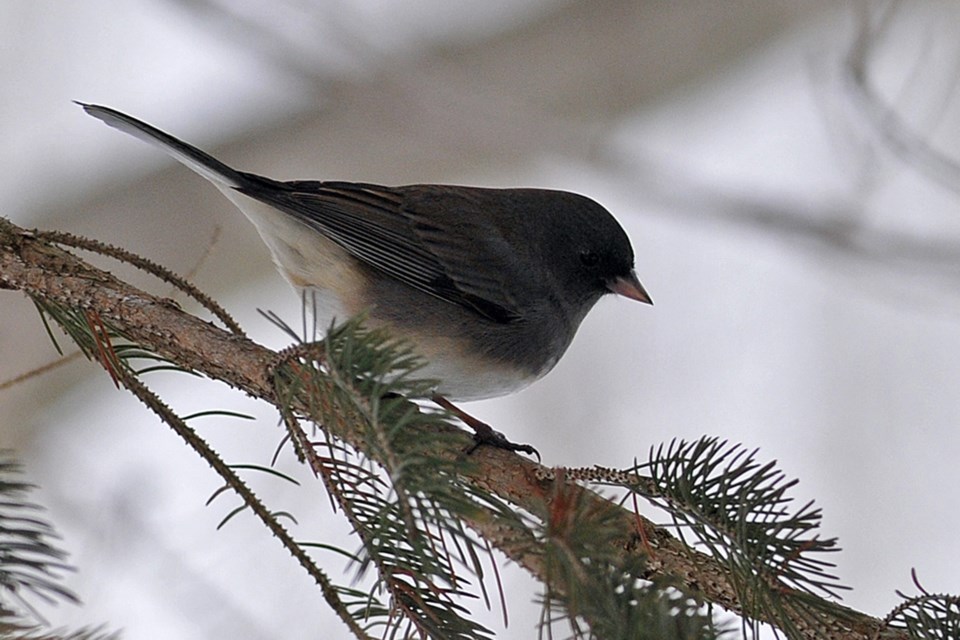There is a small cluster of feathers stuck on my kitchen window. Some are white, a couple are light grey. Perhaps they’re from a junco — a junco that is no longer part of the flock that picks up seeds from the backyard feeder.
The quiet “THWAP” that brought my attention to the window has been heard here before. It’s usually the result of a small bird being frightened or pursued by a hawk or shrike at the feeders, the little prey species flying full tilt into the protection of a nearby tangle of tree branches… only to find to its very sudden surprise that the “forest” is just a reflection on a window pane.
Sometimes the victim just needs a few quiet minutes to collect its thoughts, its breath and then, like a dazed prize-fighter, get back in the game of food finding. And sometimes it’s the end. And, unfortunately, sometimes it’s a broken wing.
It’s this third possibility that sets off an emotional roller-coaster for many bird watchers… their lust for having birds lured close-by for easy viewing has now resulted in one of the birds needing care; and its natural companions are really lousy at rendering aid of any kind.
So now what to do? Let the cat outside? Sit back and hope the sharp-shinned hawk makes a fly-by? Or, get the snow boots on and go there yourself and attempt a rescue? Believe me, it can become a real ‘push me-pull you” of emotions as to whether or not to spring into action.
Part of our hesitation is no doubt justified by our total lack of knowledge as to what to do once the avian victim is caught and boxed. Birds tend to be highly stressed when the ability of flight has been taken away, and beyond that first step of keeping it quiet in a box… we are left feeling more than a little helpless.
Once upon a time, in many a young person’s life, was the dream of keeping and caring for a wild animal. Mind you, this was back when more of us lived in a rural setting than an urban one, and a corner of the hay mow in the barn or an old chicken coop was a handy ‘animal hospital’. Many a raccoon, crow, squirrel and rabbit has died a slow and painful death under these conditions.
Nowadays, most young people have been conditioned to avoid wildlife, especially handling them. (They are all just dripping with disease, you know.) But the reality is that we do interact with wildlife, whether the scene be the back yard feeder or out on shoulder of the highway.
So here’s a few things to keep in mind when you find yourself in such a pickle… no matter what you do or don’t do, the injured animal is likely to die. Hard fact. Secondly, it is against the law to possess a wild animal without a permit or authorization of some sort.
So who ya gonna call?
There are several licensed animal rehabilitation centres in Ontario, some very specialized (e.g. hawks and owls only) and others accepting a much broader list of smooshed animals. And thank goodness for these places.
To become a wildlife rehabilitation centre requires authorization from the Province, inspection of the facilities, trained staff, often a large tract of land… and private money. The government does not actually operate any of these places, they are all, like any non-government organization, privately funded by volunteers, donors, sponsors and supporters.
There are a few government grants to assist with some aspects of a centre’s operation, but the bulk of the funding comes from folks like you and me. And that’s something to keep in mind when you reach out for help with your dilemma of a bird in a box.
Many people across the province have stepped up and have become volunteer drivers, picking up and taxiing injured wildlife from Pont A (your back yard) to the operating room at some Point B (often many kilometres distance away). There are even times when a rely is set up, transporting that crushed turtle halfway across the province, 100 kilometres at a jump, to obtain specialized treatment and care.
Of course by now you are wondering just how does one access this awesome service. I could start listing the centres one-by-one… Shades of Hope, Aspen Valley, Georgian Bay Turtle Hospital… but my list may not cover your situation.
So this is what you are going to do… go to the website called “Ontario Wildlife Rescue.” Just type that into the search line, hit enter, and your prayers will be answered. You can search their list by location or by the species they can treat. Fire off an e-mail or make a telephone call to the appropriate organization and it’s like “Wildlife 911.”
These folks are amazing at what kinds of animals they can work with: songbirds, waterfowl, bear cubs, deer fawns, turtles, hawks, owls and even raccoons and squirrels.
Again, a little nudge here, when someone comes to pick up that precious cargo, make sure the assisting organization gets a little attention from your bank account. That step is just as critical as any other.
